Jackson M.J. Micro and Nanomanufacturing
Подождите немного. Документ загружается.

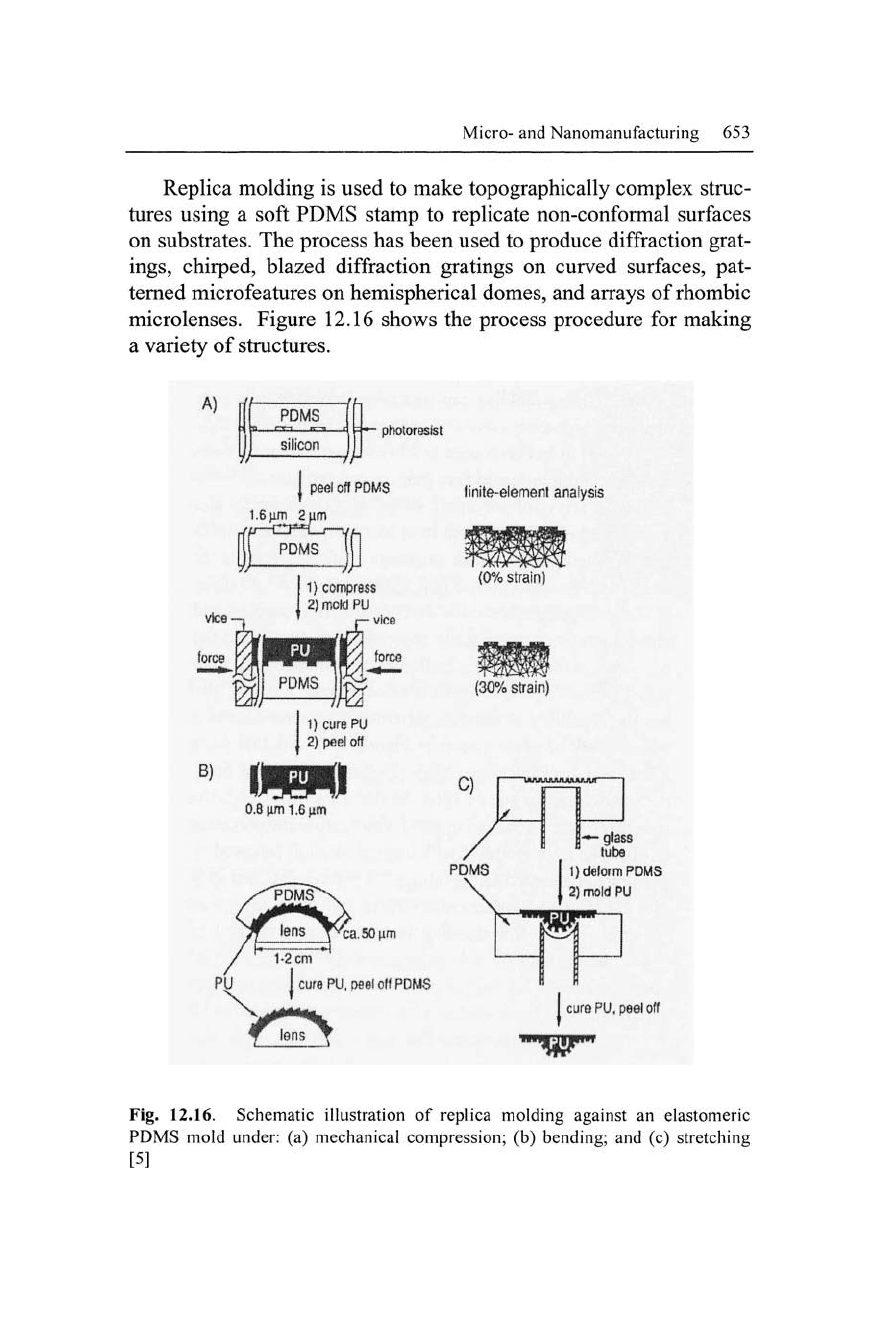
Micro- and Nanomanufacturing 653
Replica molding is used to make topographically complex struc-
tures using a soft PDMS stamp to replicate non-conformal surfaces
on substrates. The process has been used to produce diffraction grat-
ings,
chirped, blazed diffraction gratings on curved surfaces, pat-
terned microfeatures on hemispherical domes, and arrays of rhombic
microlenses. Figure 12.16 shows the process procedure for making
a variety of structures.
A)
PDMS
w
silicon
J
• photoresist
I peel off PDMS
I
PDMS
1) compress
2) mold PU
B)
I PDMS \[.
it
force
1) cure PU
2) peel off
finite-elemeni analysis
(30%
strain)
C)
PDMS
|ens__p^a 50 |irn
1-2
cm
PU J cure
PU,
oeel oft PDMS
-^ glass
tube
1)
deform PDMS
, 2) mold PU
n-i
I cjre
PU,
peel off
Fig. 12.16. Schematic illustration of replica molding against an elastomeric
PDMS mold under: (a) mechanical compression; (b) bending; and (c) stretching
[5]
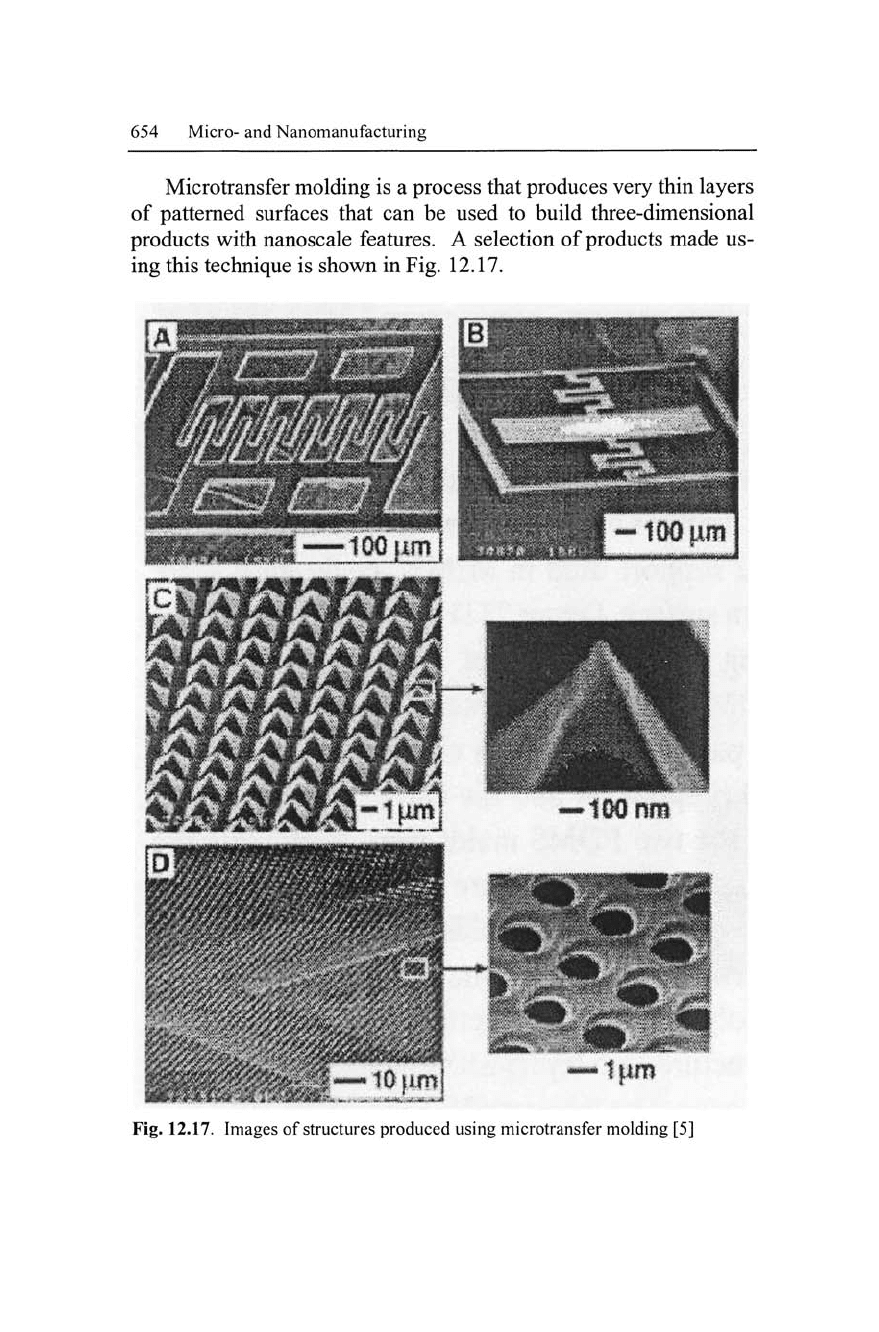
654 Micro- and Nanomanufacturing
Microtransfer molding is a process that produces very thin layers
of patterned surfaces that can be used to build three-dimensional
products with nanoscale features. A selection of products made us-
ing this technique is shown in Fig. 12.17.
Fig. 12.17. Images of structures produced using microtransfer molding [5]
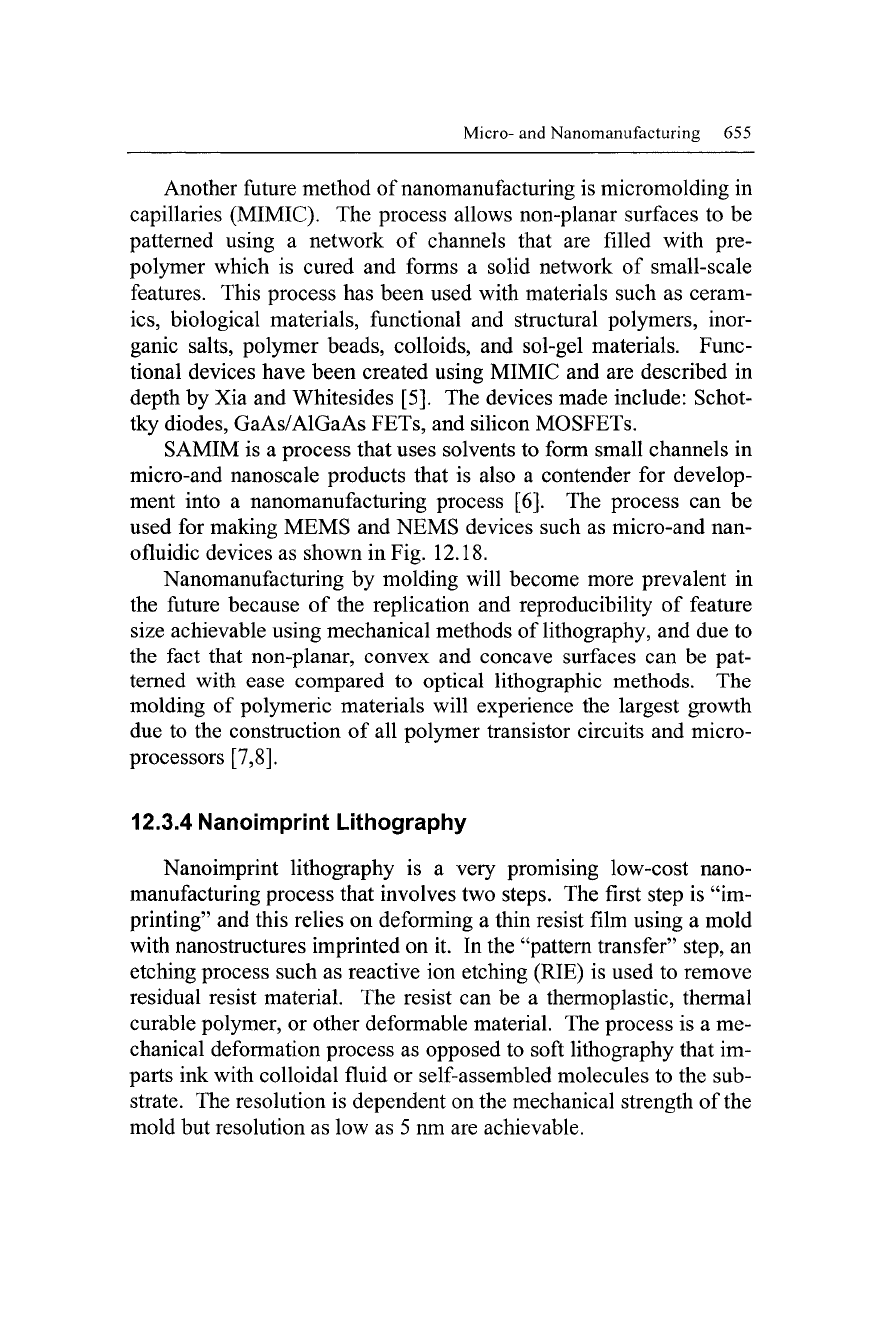
Micro- and Nanomanufacturing 655
Another future method of nanomanufacturing is micromolding in
capillaries (MIMIC). The process allows non-planar surfaces to be
patterned using a network of channels that are filled with pre-
polymer which is cured and forms a solid network of small-scale
features. This process has been used with materials such as ceram-
ics,
biological materials, functional and structural polymers, inor-
ganic salts, polymer beads, colloids, and sol-gel materials. Func-
tional devices have been created using MIMIC and are described in
depth by Xia and Whitesides [5]. The devices made include: Schot-
tky diodes, GaAs/AlGaAs FETs, and silicon MOSFETs.
SAMIM is a process that uses solvents to form small channels in
micro-and nanoscale products that is also a contender for develop-
ment into a nanomanufacturing process [6]. The process can be
used for making MEMS and NEMS devices such as micro-and nan-
ofluidic devices as shown in Fig. 12.18.
Nanomanufacturing by molding will become more prevalent in
the future because of the replication and reproducibility of feature
size achievable using mechanical methods of lithography, and due to
the fact that non-planar, convex and concave surfaces can be pat-
terned with ease compared to optical lithographic methods. The
molding of polymeric materials will experience the largest growth
due to the construction of all polymer transistor circuits and micro-
processors
[7,8].
12.3.4 Nanoimprint Lithography
Nanoimprint lithography is a very promising low-cost nano-
manufacturing process that involves two steps. The first step is "im-
printing" and this relies on deforming a thin resist film using a mold
with nanostructures imprinted on it. In the "pattern transfer" step, an
etching process such as reactive ion etching (RIE) is used to remove
residual resist material. The resist can be a thermoplastic, thermal
curable polymer, or other deformable material. The process is a me-
chanical deformation process as opposed to soft lithography that im-
parts ink with colloidal fluid or self-assembled molecules to the sub-
strate. The resolution is dependent on the mechanical strength of the
mold but resolution as low as 5 nm are achievable.
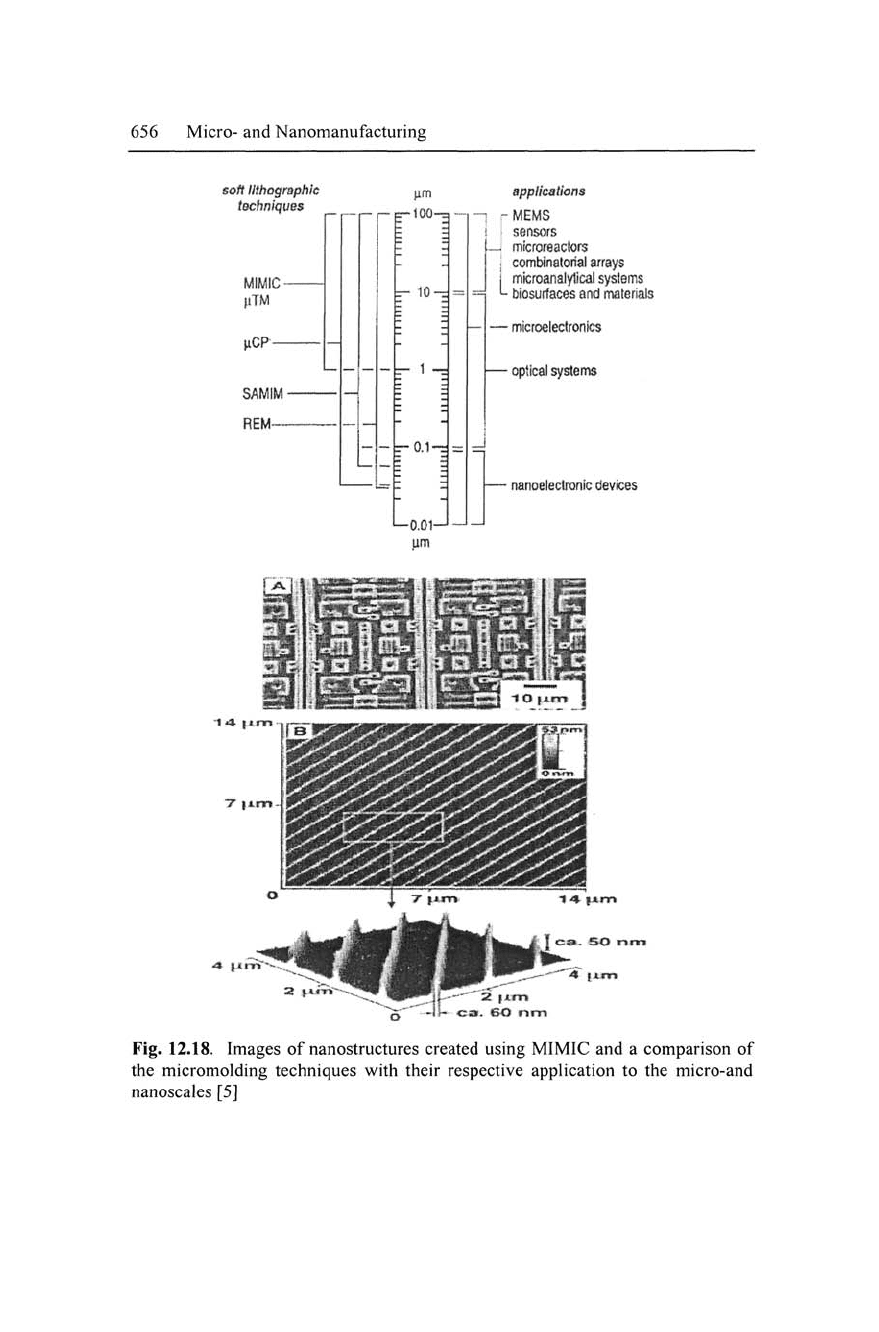
656 Micro- and Nanomanufacturing
soft Uthogrnphic
techniques
MIMiC -
HTM
HCP
—
SAMIM -
REM™-
•100-
k- 10-
t-0.1-
-0,01-
applications
1 -MEMS
! '•
sensors
—. microreaclors
J combinatorial arrays
j mfcroanalyticai systems
L biosurfaces and materials
— microelectronics
- optical systenns
• nanoeleclronic devices
-"' 2 (Am
oa.
&0 rim
Fig. 12.18. Images of nanostructures created using MIMIC and a comparison of
the micromolding techniques with their respective application to the micro-and
nanoscales [5]
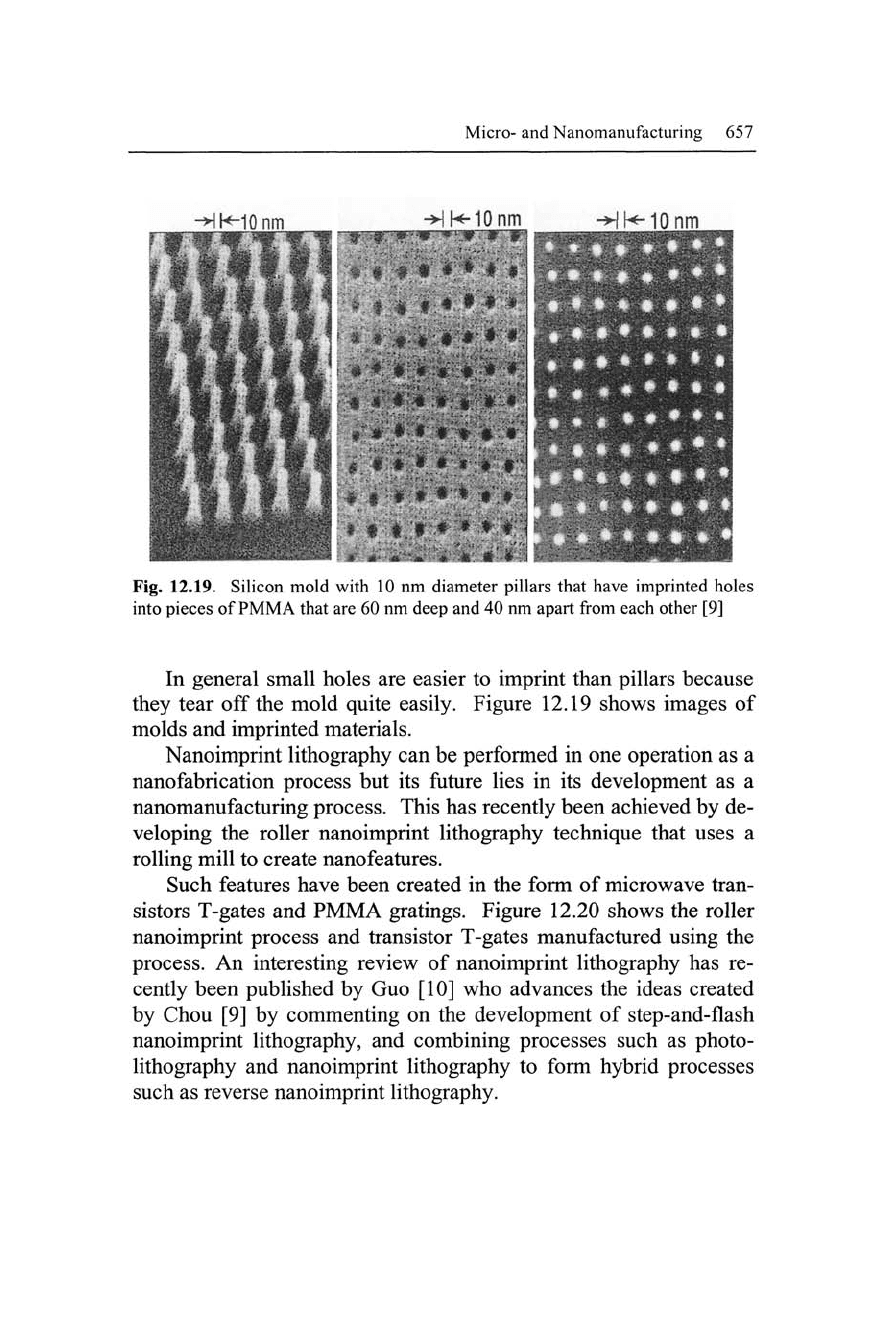
Micro- and Nanomanufacturing 657
-HH-jOnm
-^N-10nm
"Hk-10nm
-- • • • • •
Fig. 12.19. Silicon mold with 10 nm diameter pillars that have imprinted holes
into pieces of PMMA that are 60 nm deep and 40 nm apart from each other [9]
In general small holes are easier to imprint than pillars because
they tear off the mold quite easily. Figure 12.19 shows images of
molds and imprinted materials.
Nanoimprint lithography can be performed in one operation as a
nanofabrication process but its future lies in its development as a
nanomanufacturing process. This has recently been achieved by de-
veloping the roller nanoimprint lithography technique that uses a
rolling mill to create nanofeatures.
Such features have been created in the form of microwave tran-
sistors T-gates and PMMA gratings. Figure 12.20 shows the roller
nanoimprint process and transistor T-gates manufactured using the
process. An interesting review of nanoimprint lithography has re-
cently been published by Guo [10] who advances the ideas created
by Chou [9] by commenting on the development of step-and-flash
nanoimprint lithography, and combining processes such as photo-
lithography and nanoimprint lithography to form hybrid processes
such as reverse nanoimprint lithography.
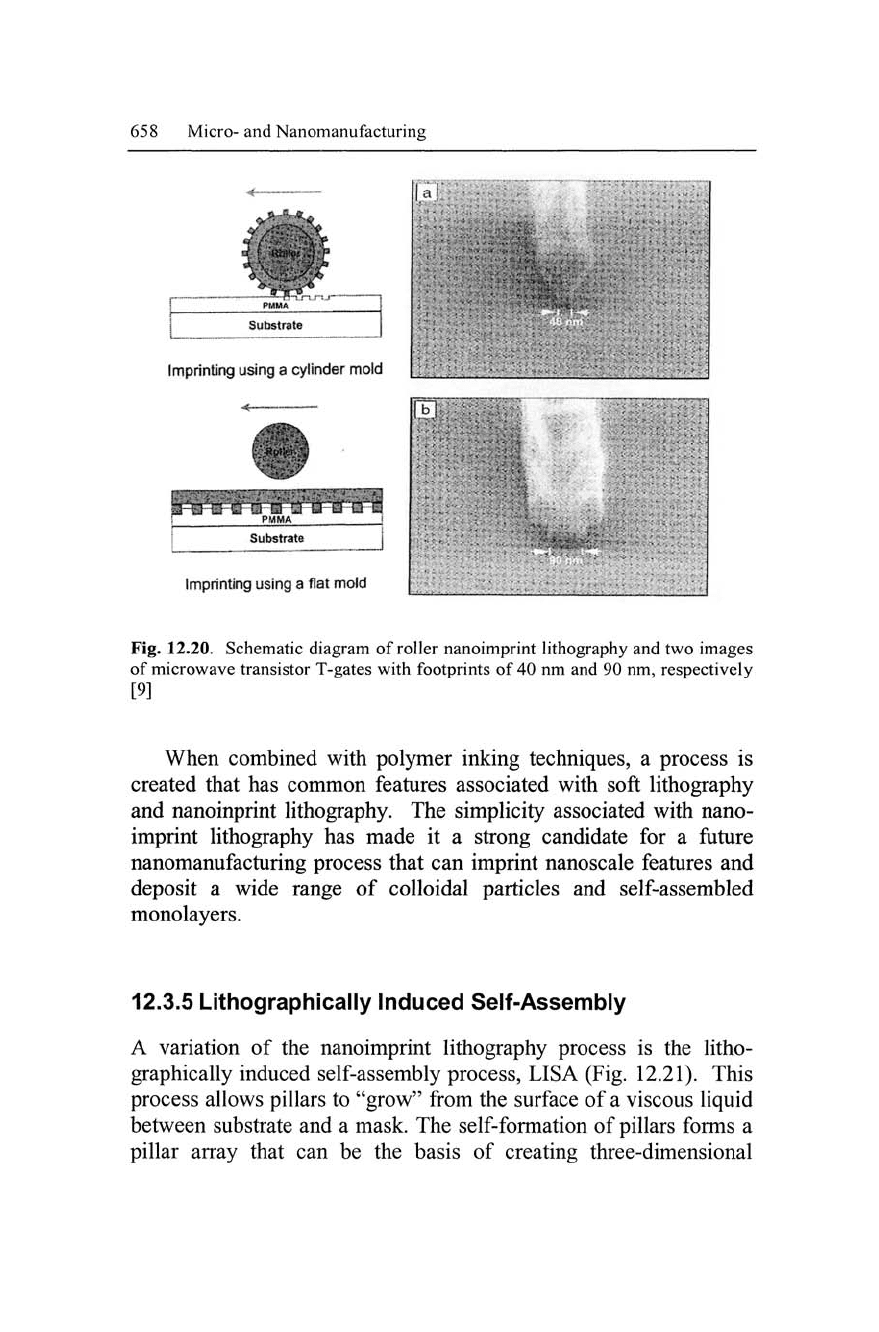
658 Micro-and Nanomanufacturing
imprinting using a cylinder mold
i^H^S^13^-!3'#%^-tf4
Substrate
J
Imprinting using a flat mold
Fig. 12.20. Schematic diagram of roller nanoimprint lithography and two images
of microwave transistor T-gates with footprints of 40 nm and 90 nm, respectively
[9]
When combined with polymer inking techniques, a process is
created that has common features associated with soft lithography
and nanoinprint lithography. The simplicity associated with nano-
imprint lithography has made it a strong candidate for a future
nanomanufacturing process that can imprint nanoscale features and
deposit a wide range of colloidal particles and self-assembled
monolayers.
12.3.5 Lithographically Induced Self-Assembly
A variation of the nanoimprint lithography process is the litho-
graphically induced self-assembly process, LISA (Fig. 12.21). This
process allows pillars to "grow" from the surface of a viscous liquid
between substrate and a mask. The self-formation of pillars forms a
pillar array that can be the basis of creating three-dimensional
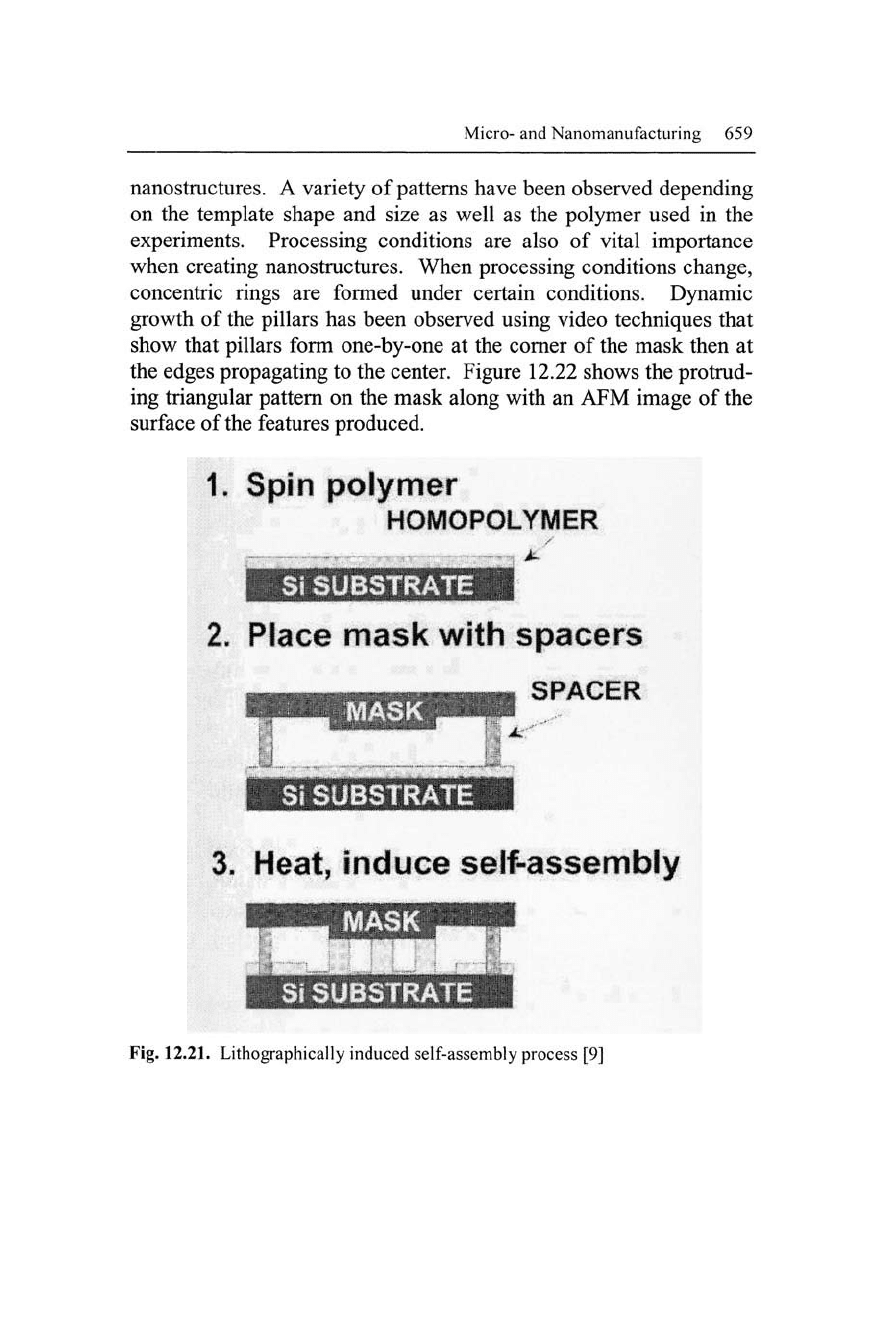
Micro- and Nanomanufacturing 659
nanostructures. A variety of patterns have been observed depending
on the template shape and size as well as the polymer used in the
experiments. Processing conditions are also of vital importance
when creating nanostructures. When processing conditions change,
concentric rings are formed under certain conditions. Dynamic
growth of the pillars has been observed using video techniques that
show that pillars form one-by-one at the comer of the mask then at
the edges propagating to the center. Figure 12.22 shows the protrud-
ing triangular pattern on the mask along with an AFM image of the
surface of the features produced.
1.
Spin polymer
HOMOPOLYMER
Si SUBSTRATE
2.
Place mask with spacers
SPACER
Si SUBSTRATE
3. Heat, Induce self-assembly
^^^-WIASK_^^
^HHMHI
mm
m
Si SUBSTRATE |
Fig.
12.21.
Lithographically induced self-assembly process [9]
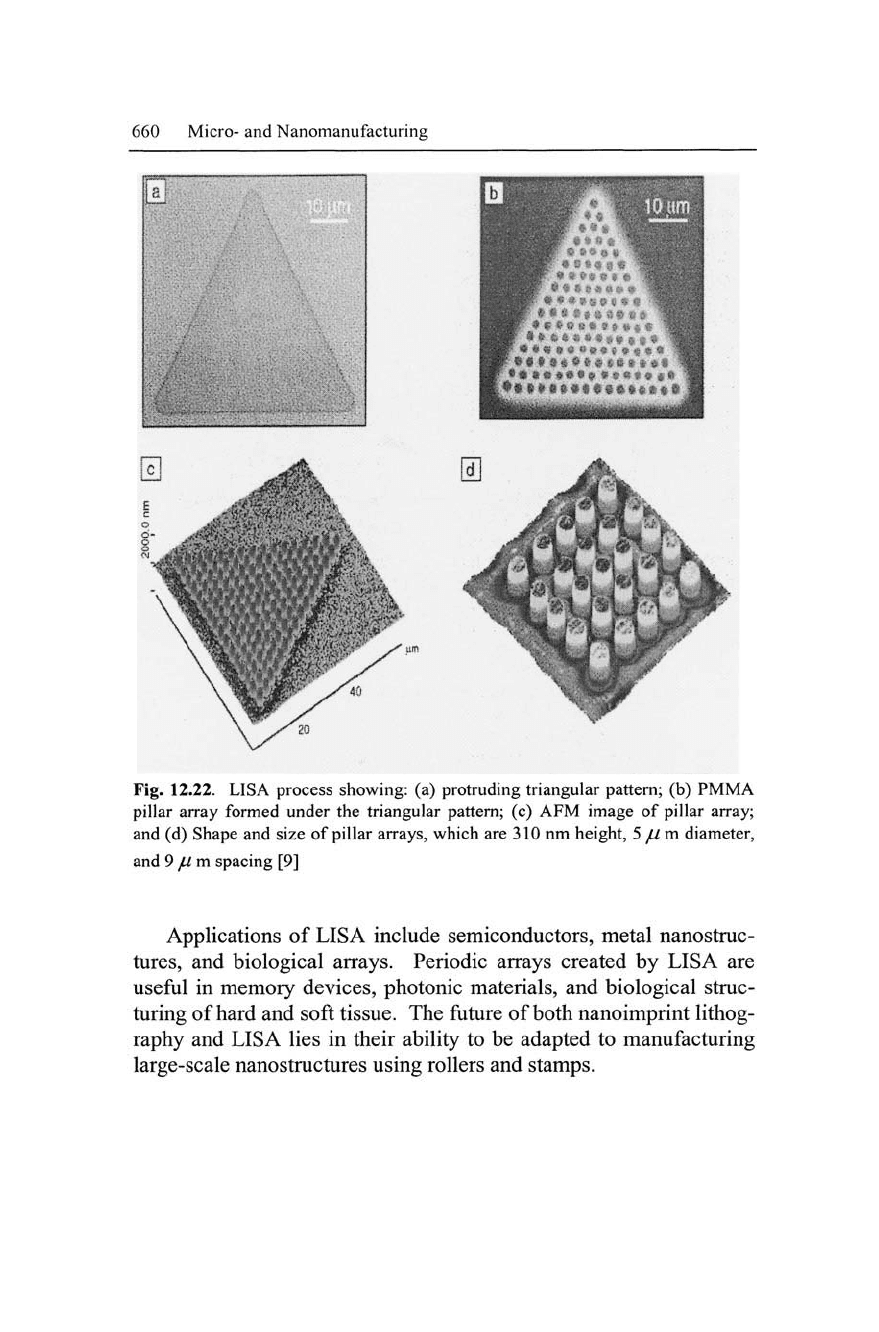
660 Micro- and Nanomanufacturing
Fig. 12.22. LISA process showing: (a) protruding triangular pattern; (b) PMMA
pillar array formed under the triangular pattern; (c) AFM image of pillar array;
and (d) Shape and size of pillar arrays, which are 310 nm height, 5 // m diameter,
and 9 // m spacing [9]
Applications of LISA include semiconductors, metal nanostruc-
tures,
and biological arrays. Periodic arrays created by LISA are
useful in memory devices, photonic materials, and biological struc-
turing of hard and soft tissue. The future of both nanoimprint lithog-
raphy and LISA lies in their ability to be adapted to manufacturing
large-scale nanostructures using rollers and stamps.
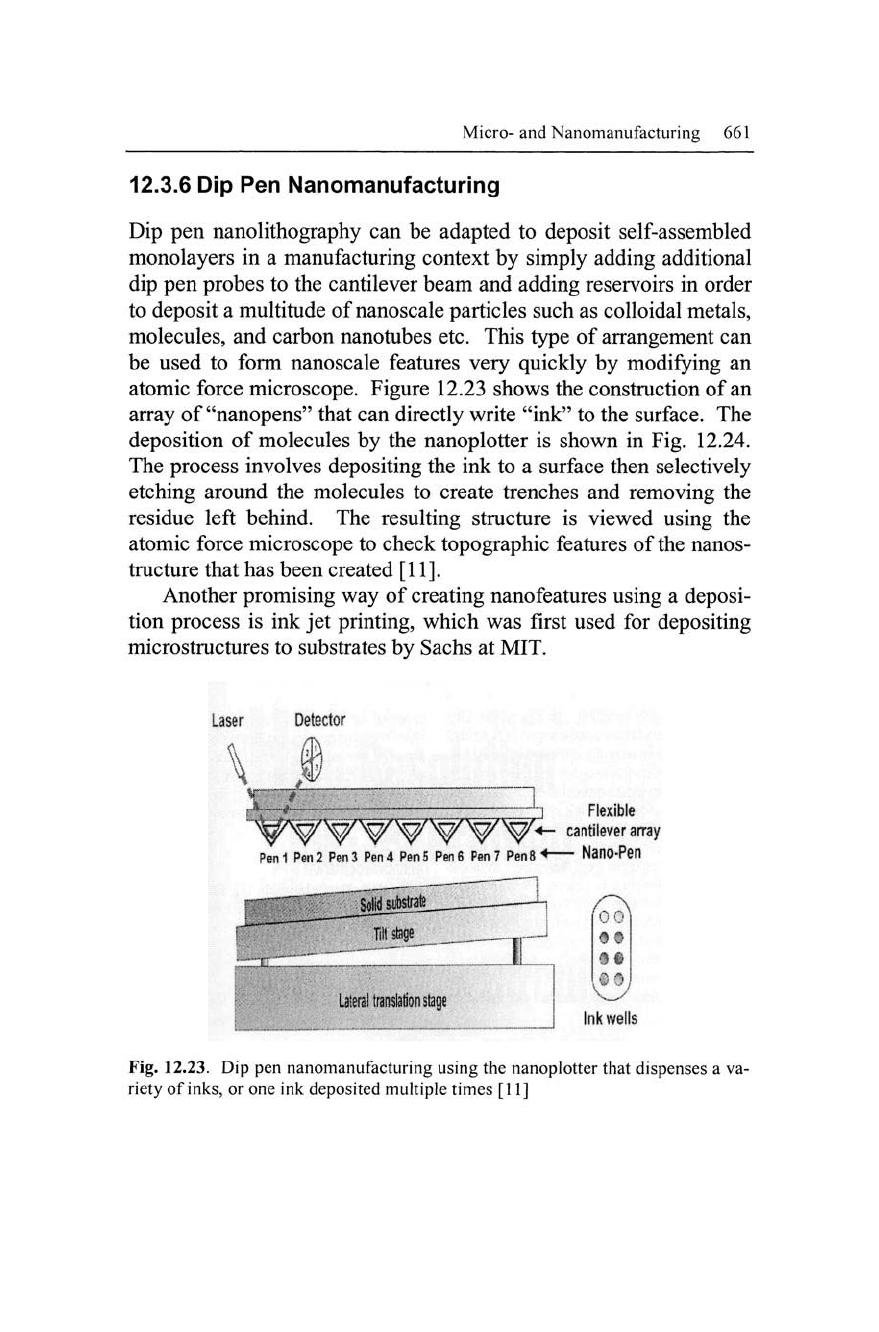
Micro-and Nanomanufacturing 661
12.3.6 Dip Pen Nanomanufacturing
Dip pen nanolithography can be adapted to deposit self-assembled
monolayers in a manufacturing context by simply adding additional
dip pen probes to the cantilever beam and adding reservoirs in order
to deposit a multitude of nanoscale particles such as colloidal metals,
molecules, and carbon nanotubes etc. This type of arrangement can
be used to form nanoscale features very quickly by modifying an
atomic force microscope. Figure 12.23 shows the construction of an
array of "nanopens" that can directly write "ink" to the surface. The
deposition of molecules by the nanoplotter is shown in Fig. 12.24.
The process involves depositing the ink to a surface then selectively
etching around the molecules to create trenches and removing the
residue left behind. The resulting structure is viewed using the
atomic force microscope to check topographic features of
the
nanos-
tructure that has been created [11].
Another promising way of creating nanofeatures using a deposi-
tion process is ink jet printing, which was first used for depositing
microstructures to substrates by Sachs at MIT.
Laser
\\
Detector
V"^"^"
X—^"
Flexible
^''^^^^'^^^^
cantilever array
Pen1 Pen 2 Pen 3 Pen 4 Pen5 Pen 6 Pen 7 ?enB< Nano-Pen
Till Stage
:::::£.::.
ZE
Lslefal translation stage
(5
0
9§
Inkwells
Fig. 12.23. Dip pen nanomanufacturing using the nanoplotter that dispenses a va-
riety of
inks,
or one ink deposited multiple times [11]
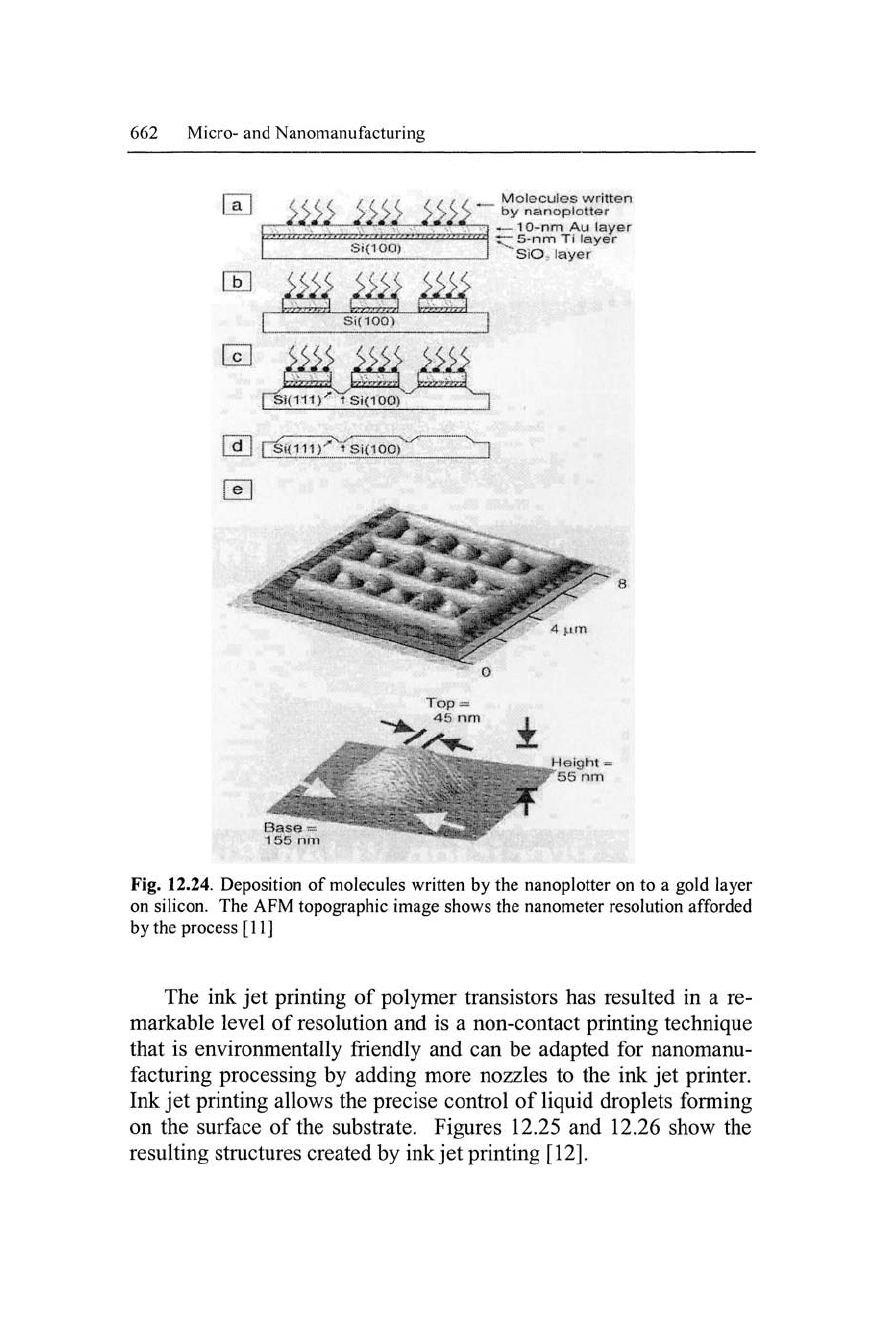
662 Micro- and Nanomanufacturing
Molecules written
<><>>> >>S> yyyy
'" ^y
nanoplotter
^^...*,rf..»,.._.„*..A.*.^ .#,*.M„rf. —.lO-nm Au layer
'-"R C~ 5-nm
Ti
layi
.J ^"SiO, layer
layer
er
E iii5 iii5 iii5
ra iiii i^ ,iiii
}r'iy77rt-|^ yrr-rr^i^-A^
^rrr-Trr,\^
rSi(110^ tSi(IOO)
i
Fig.
\1,1A.
Deposition of molecules written by the nanoplotter on to
a
gold layer
on silicon. The AFM topographic image shows the nanometer resolution afforded
by the process [11]
The ink jet printing of polymer transistors has resulted
in a
re-
markable level of resolution and is
a
non-contact printing technique
that is environmentally friendly and can be adapted for nanomanu-
facturing processing by adding more nozzles
to
the ink jet printer.
Inkjet printing allows the precise control of liquid droplets forming
on the surface of the substrate. Figures 12.25 and 12.26 show the
resulting structures created by Inkjet printing [12].
